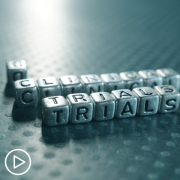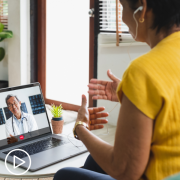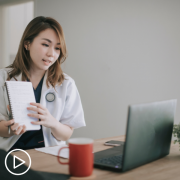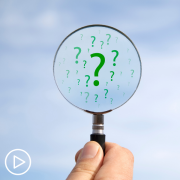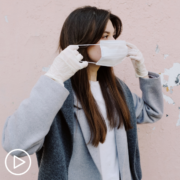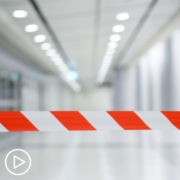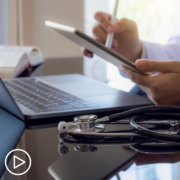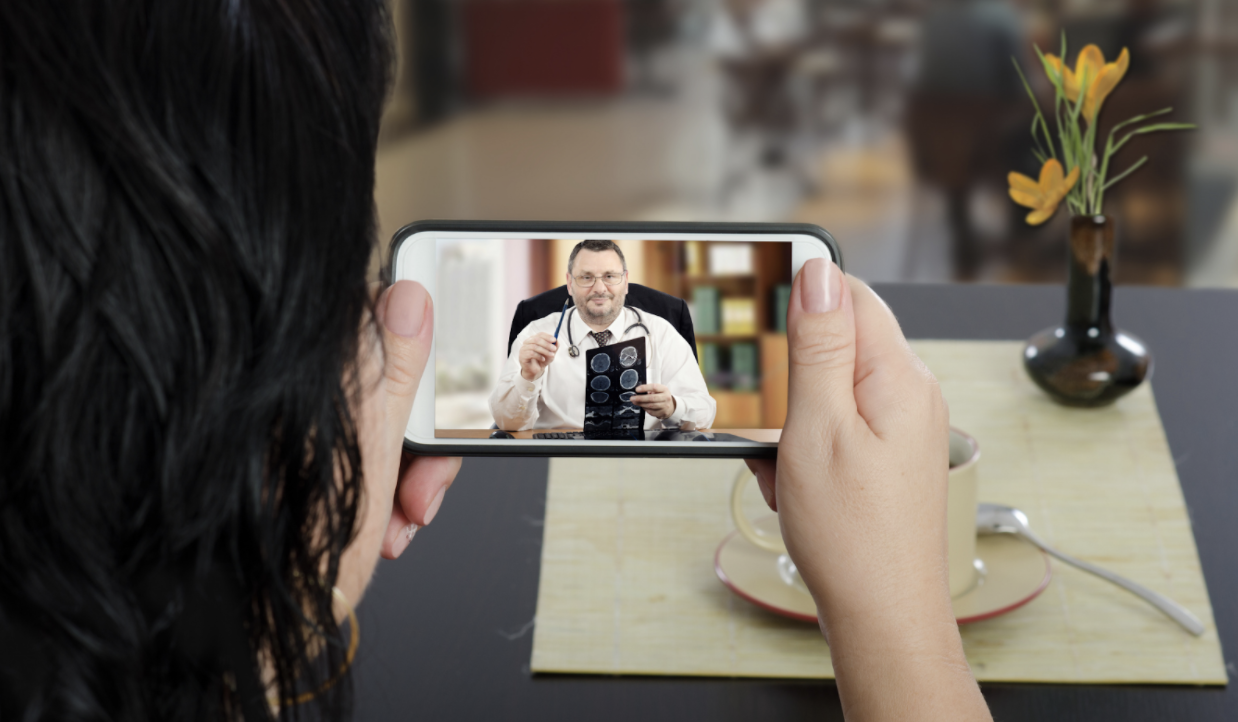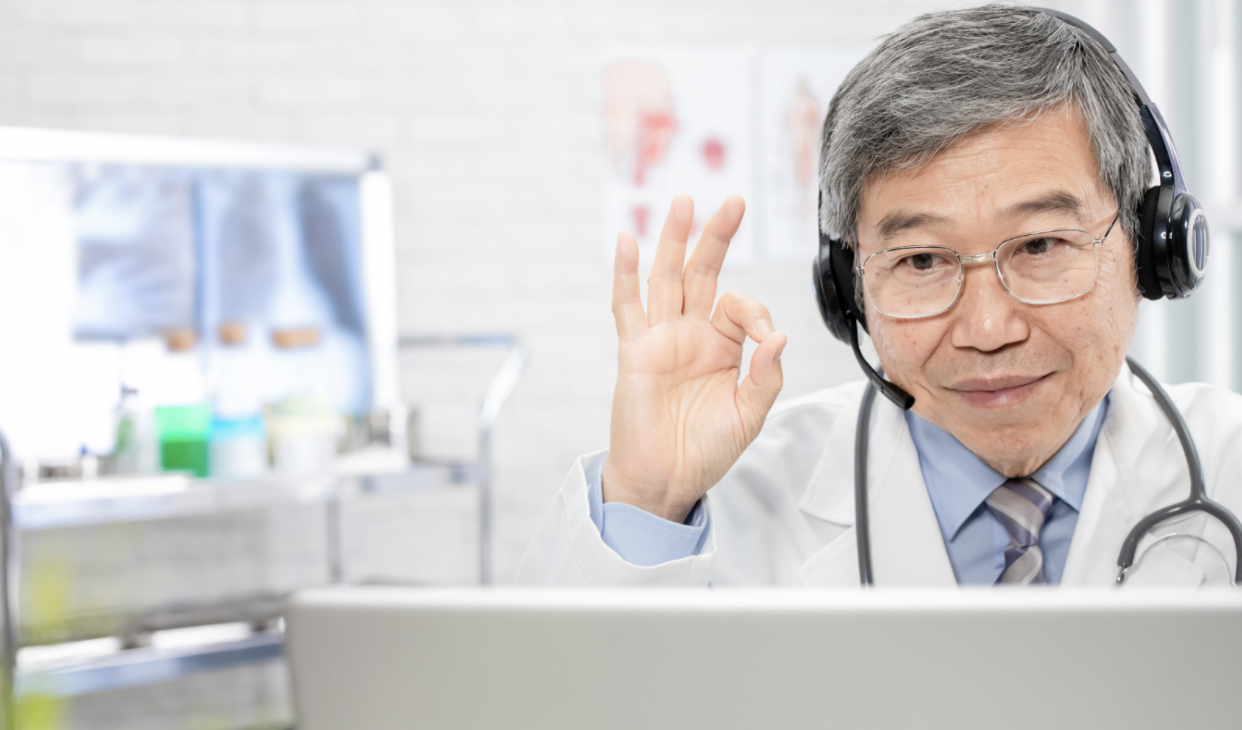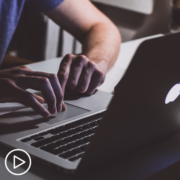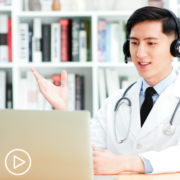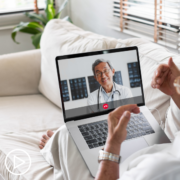Tag Archive for: telehealth
Lung Cancer Patient Shares Why Telemedicine Should Be a Long-Term Tool
Lung Cancer Patient Shares Why Telemedicine Should Be a Long-Term Tool from Patient Empowerment Network on Vimeo.
Can lung cancer patients look to telemedicine as a long-term tool in their care? Watch as lung cancer patient Jill explains how telehealth has been a benefit for her care and how it can serve as a benefit for other patients.
See More From Lung Cancer TelemEDucation
Related Programs:
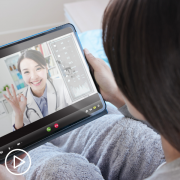
|

|
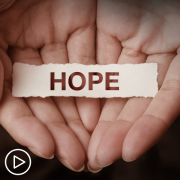
Lung Cancer Advocate Shares Importance of Staying Hopeful During Pandemic
|
Transcript:
Jill:
In the future, I hope that telemedicine plays a really significant role in my care and in the care of others as well, so I would really like to not have to travel to my cancer clinic for every single appointment. For some of them, I definitely want to go. There are times when we want to look our doctor or nurse in the eye and really have strong, stronger communication, but for the most part, I would rather not have to travel and I live really close to my cancer center, so I always think about people who live farther away, and there are so many people who travel hours, there are people who travel days to get to their appointments, there are people who have to leave their communities and be, away for an extended period of time, and that’s not something that I would want to do, especially when we’re in a going counter treatment, we can feel so alone and fragile, and I would rather that people had more support and other people with them could stay at home, could stay in their communities and just have a call and their people could be with them if they wanted it during the call, they can all gather around and listen to.
And I think it matters so much. It’s not just convenience, it’s better care for people to have their loved ones near them, that’s one thing we’ve learned during COVID, even more so that it’s not good to be alone. It’s good to have our loved ones near us supporting us, and so as much as possible, if we can keep telemedicine as an option to use for the times when it doesn’t really matter if we’re in person or not, let’s make that choice, let’s make second opinions available let’s work out whatever permissions need to be in place for people to get care across regional lines or state lines, let’s get those things in place so that we can provide the best care possible, and let’s always be thinking about our most vulnerable people, and those are usually the people in the rural and remote regions, the people with a really hard cancer diagnosis, the people who are feeling alone and vulnerable, let’s take it, care of them.
Lung Cancer Patient Shares Why Telemedicine Is an Important Tool
Lung Cancer Patient Shares Why Telemedicine Is an Important Tool from Patient Empowerment Network on Vimeo.
How can telemedicine serve as a vital tool in lung cancer care? Watch as stage IV lung cancer patient Jill shares how telehealth has helped her during the COVID-19 pandemic and how she views it in the future of her care.
See More From Lung Cancer TelemEDucation
Related Programs:

|

|
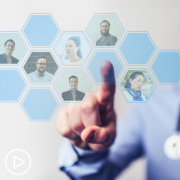
Lung Cancer Patient Shares Why Telemedicine Should Be a Long-Term Tool
|
Transcript:
Jill:
I was diagnosed with stage IV lung cancer back in 2013, and prior to the COVID pandemic, I had never had a telemedicine appointment, but now that I’ve had quite a few.
I think they’re such an important tool in lung cancer care, especially during a pandemic, when they protect us from exposure to various potential infections, not just COVID, but it can protect us from illness, so that’s terrific. But also, they’re really convenient, I just have a quick 10-minute appointment, there is no waiting in the waiting room, there’s no traveling to the clinic, which is…I’ll be honest, that’s not a very big inconvenience for me because I live quite close to my cancer center, but especially for people in rural and remote regions, what a game changer it can be to just be able to talk on the phone or perhaps have a video chat with a health care provider. So, I think that telemedicine is a very important tool in lung cancer care, and I hope that it will continue, maybe not 100 percent of the time, but there will still be available to him after the pandemic is over.
MPN Patient Shares Advice for Making the Most of Telemedicine Visit
MPN Patient Shares Advice for Making the Most of Telemedicine Visit from Patient Empowerment Network on Vimeo.
Myeloproliferative neoplasm patient Debbie has had the opportunity to utilize telemedicine in her care. Watch as she shares the pros and cons of telehealth methods in her blood cancer monitoring and her advice to other patients for optimizing virtual visits.
See More From the MPN TelemEDucation Resource Center
Related Resource:
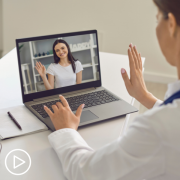
|
Transcript:
Debbie:
I think there is definitely a place for telemedicine in our care. It has enabled us to, or enable me to keep in touch with my hematologist and to understand where my blood counts currently are. What I would also say is, it’s…that there are positives and negatives. I think that the positive of it is the fact that I’ve got a regular update on what my blood counts actually are. I think the negatives of it can be, is that it is quite easy just to move the conversation quite quickly forward. It’s easier for me to just say, everything’s all okay. Thank you for updating me over the telephone, then it is perhaps if I was actually sat in front of somebody.
I think that the challenges it presents is that personal touch, is that feeling of being able to have a one-to-one relationship with your consultant. I don’t think you have that over the telephone.
So, some of the tips that I would share are that you keep in regular contact with your hematologist, you keep regular information on your blood counts, but you keep in a very, very safe environment. You do keep in a safe environment, and that I think is something that’s enormously important. A tip that I would probably give is that make sure that in between your appointments, you do what you would do regularly on a face-to-face and make notes of the things that you want to talk about…because I quite often put the phone down and think, I wish I had said that when I go to the hospital, I will have my notes in front of me and I put them on the table, and I’ll cross-check them with the hematologist at the time, I tend not to do that on the telephone, and perhaps I should, so I would definitely recommend that you treat the tele appointment exactly the same as you would the hospital appointment.
How Has the Pandemic Reshaped Head and Neck Cancer Care?
How Has the Pandemic Reshaped Head and Neck Cancer Care? from Patient Empowerment Network on Vimeo.
How has head and neck cancer care changed from the COVID-19 pandemic? Watch as expert Dr. Samantha Tam from Henry Ford Health System shares situations for in-person vs. telemedicine visits.
See More From The Head & Neck Cancer TelemEDucation Empowerment Resource Center
Related Resources:
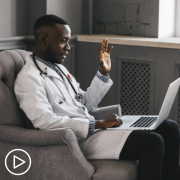
|
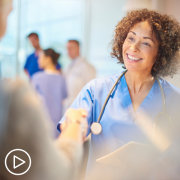
|
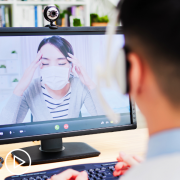
|
Transcript:
Samantha Tam, MD, FRCSC, MPH:
COVID-19 has significantly changed how healthcare is delivered to patients with head and neck cancer. Traditionally head and neck cancer care has been delivered in-person visits because patients with head and neck cancers are often difficult to examine on a virtual platform, and on top of that, many patients have difficulties with communication, just given the ramifications of the disease. However, with COVID-19, we had a conscious effort to shift a lot of our care from in-person to virtual visits, and the area of telemedicine has been therefore greatly expanded in patients with head and neck cancer diagnosis. How head and neck cancer patients have been able to utilize telemedicine has been varied according to whether or not these patients are coming in for new diagnoses for follow-up care, for post-op diagnoses or for care during their treatment. And I feel that virtual care is really complementary as opposed to a substitute for patients with head and neck cancer because certainly there are innate difficulties in communication through the virtual platforms, as well as innate difficulties with examining patients adequately through the virtual platform.
That being said, there’s a lot of care, for example, with allied health professionals, or surveillance care that can be completed on a virtual platform that may use healthcare delivery to patients that may not be able to access in-person care on a regular basis
What Opportunities Does Telemedicine Present for Breast Cancer Patients?
What Opportunities Does Telemedicine Present For Breast Cancer Patients? from Patient Empowerment Network on Vimeo.
Does telemedicine present certain advantages for breast cancer patients? Expert Dr. Regina Hampton from Luminis Health Doctors Community Hospital shares benefits that she’s seen in the breast cancer community and her perspective about the future of telemedicine.
See More from the Breast Cancer TelemEDucation Resource Center
Related Resource:
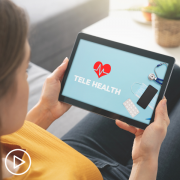
|
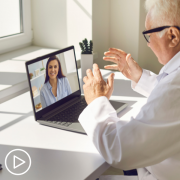
|
Transcript:
Dr. Regina Hampton:
I think telemedicine has been great for the breast cancer community. I found in my personal practice, I do quite a number of visits and conversations prior to starting the first treatment. So, what’s nice is because we know the patient may be seeing several different providers, I do my initial visit and then the subsequent visits leading up to, say, surgery, we do by telemedicine. And what’s great about that is it allows us to dial in another support person, you can usually dial in at least two or three more people who can be a part of the conversation and hear the discussion, it also allows the patient to really…if they’re working full-time to be able to save that time, because maybe there’s another provider that they have to go see or they have to get their pre-op work-up. So it really just provides more access. And then if they just have a simple question, they don’t have to make a whole visit, take off half of their day and travel. We can either jump on the phone or jump on a quick video call, so I think it really has just opened up for not only the patients, but also the providers, and just given more access to care and really allows, I think us as providers to really meet people where they are. I’ve had people who’ve traveled or they had to go take care of a sick loved one, and we could jump on a call to do our office visit, and they could still do the things that they needed to do that may have come up unexpectedly. So, I think telemedicine is here to stay, and I think it’s only going to grow and grow and really provide more patients with access to providers.
How Can Lung Cancer Patients Ensure Quality Care No Matter Location?
How Can Lung Cancer Patients Ensure Quality Care No Matter Location? from Patient Empowerment Network on Vimeo.
Now that lung cancer patients have access to in-person and telemedicine visits, how can they ensure quality care no matter location? Experts Dr. Nicole Rochester and Dr. Olugbenga Okusanya share their advice on maximum travel times to in-person providers, when telemedicine visits make sense, and how to ensure you get the best fit for you as a patient.
See More from Best Lung Cancer Care No Matter Where You Live
Related Resource:
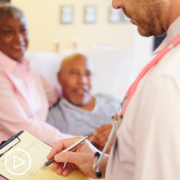
|
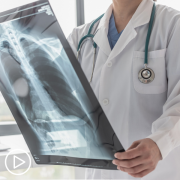
|
Transcript:
Dr. Nicole Rochester:
You mentioned telehealth, and we know that one of the barriers to receiving care, and you’ve indicated that in terms of having access to a multi-disciplinary team, having access to thoracic surgeons as opposed to general surgeons. So, we know that that is impacted by where we live, and that often our geographic location can actually be a barrier to the receipt of quality care, so I’d love for you to just talk a little bit about how patients who may be in more remote locations can make sure that they are also receiving appropriate care for their lung cancer.
Dr. Olugbenga Okusanya:
Yeah, I think this is a very substantive challenge, I think this is one of the holes in healthcare, there are these regions in the country where you just are not going to have access to any number of surgical sub-specialists or radiation oncologists, or lung cancer specific oncologists. I think that is a really big challenge. I think we have actually learned through the pandemic that the physical barriers really are not the reason to not get the best care, so I think those patients should be exquisitely interested in telehealth and in phone calls, and I think most healthcare systems now, because the reimbursements have been approved for telehealth and actually now built infrastructure to support it as an ongoing concept. So now, if you are a patient that’s in Arizona and you want to talk to a doctor who’s in New Jersey, you can do that, you can make that happen. If you find someone, you Google them, you find a friend in that area who knows someone, you can call their office and say, “I want to have a telehealth visit.” And as long as you have broadband Internet and a phone, you can do it. You can have that conversation.
So, I would advocate for people to really make sure that you at least feel like people in the sort of local regional area that you can perhaps get to maybe two, three hours away. But you can imagine a scenario where you can get there, you can try and establish some level of care and some level of rapport with them. I think that’s something that has really opened, has been one of the few good things to come out of the pandemic.
Dr. Nicole Rochester:
I was going to say the exact same thing. That is one…there haven’t been a lot of positive things, but that certainly is one of the positive outcomes of the pandemic, is this surge, and it’s not that we already had the capability, but it certainly was not being used to its maximum capacity. I appreciate that. So, speaking of telemedicine and COVID, I think one of the challenges that patients and often care partners have is understanding when is a telemedicine or telehealth visit appropriate versus when do you actually need to go see that doctor in-person, so…can you help clarify that?
Dr. Olugbenga Okusanya:
Yeah, so I think in general, even if you start with the telehealth is, I think there’s very little downside to telehealth for almost anyone in general, because a lot of the information can be garnered from the patient record, from their scans. I think in general; it gives you 85 percent of what you need out of that interaction, and it may be more convenient for the patient, a lot of times it’s actually more convenient for the doctors, doctors have now found ways to work from home. They do have to have their clinic from home, it’s a much more relaxed environment than more efficient. I think there are times like for instance, I have to make decisions about offering surgery to patients who I consider to be moderate or high risk, I think there is a benefit and having that patient come and see me in the office because they have to somehow pass what we call the eyeball test, and that is a little bit of where this disparity comes in in lung cancer surgery, because it depends on whose eyeball is looking at you, making your determination about what they think is going to happen with you in surgery.
I remember…actually one of my favorite patients ever. She had data that did not look like she would tolerate surgery, everything about her data did not look favorable. And I saw her, I remember seeing her in-person, and you could see the spark in her eye and energy that she had, and I said, “You know what, we’re going to do it.” And she did great, she did phenomenally well. And that is a case where if you’re in the population of patients that may be slightly more moderate, slightly more high-risk, and you need someone to really look you in the eye and you say, “I’m going to do what it takes to get through this.” I think that’s the patient where the in-touch, in-person visit really is that extra touch that can be benefited.
Dr. Nicole Rochester:
Wow, I love what you said about the spark in her eye and also how you connected that to health disparities, and I don’t know the race or ethnicity of the patient that you’re describing, but we certainly know that that makes a difference, and I just wonder if that had been a different physician, would they have seen that same spark? And I think it just goes back to what we were talking about earlier, and the importance of finding a physician or health care provider with whom you connect, someone that actually respects you, someone that listens to you and sees you as a whole person. So, the fact that you were willing to go beyond that data on her chart, which screamed, This is a poor surgical candidate, met her in-person, and something about her let you know that she was going to be okay.
Dr. Olugbenga Okusanya:
And that’s why in medicine and surgery are still art at the end of the day, it’s still an art. You make decisions, best informed decisions, but there’s a lot of it that is still really special and mystical in a way. And I think having that in-person interactions will let you practice that and it’s exactly what you said, you want to have a really nice relationship with the physician, especially anyone that’s going to be doing anything that might be invasive or dangerous because for the most part, you meet someone for 45 minutes and then you sign up for what could be a life-threatening event. So, you, the physician and the patient should feel really good about that interaction and whatever that energy is, it’s really important, it’s a little bit kind of sacred, I think, and I think it’s really valuable to invest in that if you don’t like the surgeon, you really don’t feel like it’s a good fit or you don’t like your oncologist, find someone else. You’ll do better in the long run, for sure.
Dr. Nicole Rochester:
That is so incredibly important. I agree, 100 percent. So much of healing is beyond just the nuts and bolts of the medical care that we provide, or in your case, the surgical care, there’s so much more to that, that’s not really well studied, but that relationship and that connection is key.
Dr. Olugbenga Okusanya:
Critical, and that’s not to say that necessarily the person has to be like the warmest, friendliest, the most fun person you ever met, some people prefer a more yes ma’am, no ma’am, clear-cut, well-defined boundaries of a relationship. Some people prefer a big hug and a laugh and a joke. So if you’re getting what you need, that’s exactly what you need. And if you’re not getting what you need, you should think about your other options
Empowered Patient and Care Partner Ask the Expert: Addressing COVID-19 Concerns
Empowered Patient and Care Partner Ask the Expert: Addressing COVID-19 Concerns from Patient Empowerment Network on Vimeo.
With COVID-19 infection and vaccine concerns, what are the key points for cancer patients and care partners to know? Expert Dr. Shaji Kumar from Mayo Clinic shares valuable information about protective measures against COVID-19 infection, vaccine side effects and effectiveness, working toward herd immunity, and cancer research benefits that have emerged from the pandemic.
See More From the Best Care No Matter Where You Live Program
Related Programs:
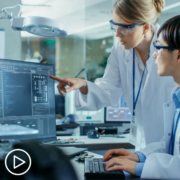
|
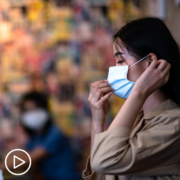
|
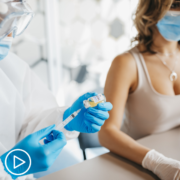
|
Transcript:
Mary Leer:
My name is Mary Leer. I’m the Breast Cancer Network Manager.
Jeff Bushnell:
And I’m Jeff Bushnell, the MPN Network Manager at the Patient Empowerment Network. I’m a caregiver.
Dr. Shaji Kumar: I
’m Shaji Kumar, a hematologist at Mayo Clinic.
Mary Leer:
Jeff and I are proud to be part of a strong team of compassionate volunteers, helping health communities adapt to the realities of living with a serious illness, living with cancer during a pandemic certainly presents another layer of challenges. So, Jeff and I will drill down to ask the important questions from the community. For this production, Empowered Patient and Care Partner Ask the Expert, we are very lucky to be joined by noted expert, Dr. Shaji Kumar, a consultant in the division of hematology at Mayo Clinic. Thank you for taking the time to join us, Dr. Kumar.
Dr. Shaji Kumar:
Thank you for having me, Mary.
Mary Leer:
Let’s start with the top of mind questions for so many of us right now, what should every patient and care partner facing a cancer diagnosis know during the pandemic?
Dr. Shaji Kumar:
I think it’s a challenging time for everyone, and it’s obviously more challenging for patients dealing with cancer at the same time, thankfully, we have a vaccine at hand that will certainly make the situation a lot better, but I think from a cancer standpoint, I think what we need to keep in mind all the precautions we talk about in terms of social distancing, masking, hand washing and all those measures apply equally to everyone, even more so to patients with cancer. And the reason why we say that it’s even more important for several reasons, one, and we continue to learn more about the pandemic and its impact on cancer, one thing that has become clear is that patients with underlying conditions including cancer are to other folks were more affected by the infection, more likely to have more severe interactions and poorer outcomes. Now, patients with cancer appear to be at a higher risk of getting the infection and then they get the infection having a more serious disease. Now, it’s hard to know how much of this is also related to the fact that patients with cancer often have to go into the hospital or the clinic, and hence are more likely to get exposed to the infection than someone who is able to just stay at home.
So that’s one thing. And second, we know that the ongoing treatment for cancer definitely suppresses the immune system, and hence places people at a higher risk of the infection itself. Now, even patients who have their past history of cancer, this appears to be some increased risk, even though this is a little bit, unclear how much more it impacts those individuals. But I think the bottom line is keep the awareness that you might be at a higher risk of getting the infection, more serious infection, and the need to take those precautionary measures in a more strict fashion, and getting the vaccination when you can get it is all things that one needs to keep in mind.
Jeff Bushnell:
Well, that’s wonderful, Dr. Kumar, you mentioned the vaccinations, I am a strong proponent of that, I happen to have been involved in the Moderna vaccine trial, which is and still enrolled, they’re doing the follow-up. I guess they’re checking the last time I was in last week, they took 8 vials of blood, I think they’re checking to see whether I have the antibodies and how long it will last, but I was very happy with the way it was conducted, they were very forthcoming with information.
It was very interesting. And out here in San Diego, where I am, we have done pretty well as a county in vaccinating people and Summer got the vaccine as well with myelofibrosis and she feels a lot better. But for cancer patients who have tested positive for COVID, are there notable consistencies amongst that group of people, and have we learned anything from those patients yet about maybe their chances of getting it more, or their reaction to it? That kind of thing.
Dr. Shaji Kumar:
We know that there’s a wide spectrum of reaction to the vaccine. The majority of the people would not notice any symptoms related to that except for some pain at the injection site. Not there are some folks, number of people who might have more or just myalgia, muscle pains, just feeling fatigue, some low-grade fevers, just feeling blah for 24-48 hours, and it seems to be not too uncommon. The reactions to the vaccine in terms of the side effects or the symptoms, there doesn’t appear to be much of a difference between cancer patients and normal individuals. Now, in terms of the efficacy of vaccination, you just mentioned Jeff, about you being checked for the antibodies, obviously, that is something that we hope will happen to all individuals who get the vaccine, but we know that is not going to be the case, there’s going to be a wide variation in terms of how strong an immune response one might develop against vaccines. Now We know from, not necessarily the COVID vaccine, but the vaccinations that have been used in the past, whether it be flu vaccines or pneumococcal vaccines, that we all get patients with cancer or patients going through treatment for cancer that can suppress the immune system, tend to have a lower response. But again, that varies quite widely from patient to patient now, there are some vaccines where we can clearly look at the antibody response and say, “Oh, this is not adequate, and we need to maybe give an extra shot.”
We just don’t have that information for COVID vaccines yet. So the way I would look at it is, even though the response to the back in a given person might be less than what we eventually would identify to be optimal, it’s likely to be better than not having to see the vaccine, so I would encourage obviously, everybody to get the vaccine. Now, what about someone who has already had an infection, what would be the response? Should we vaccinate those people? We certainly should. Again, we don’t know the immunity from a natural infection, how long would that last? That is still something that is unknown, and the vaccination dose is likely to make the responses more relevant and more durable, so I would recommend the vaccines for everyone. We don’t think one vaccine is any different from another in terms of your underlying cancer or lack thereof. So in terms of assessing for the antibodies, there is no clear guideline in terms of what one should anticipate from the vaccine, so there is really no way to say, check the antibody, and they can go ahead and get one more dose or you’re fully vaccinated. So I think the bottom line is, get the vaccine, you don’t need to necessarily test for a response, and then we continue with the usual measures for prevention.
Jeff Bushnell:
And so what would you tell the… I guess that’s pretty much the answer to the next question I had. What would you tell the patients who are in active treatment and who planned to get the vaccine just continue as normal after they get it, with all the appropriate precautions?
Dr. Shaji Kumar:
Yeah, no, I think there’s one other important aspect, Jeff, to that question you just raised, which is, what is the right timing to get vaccinated, the vaccine, and that is a question that often comes up. So patients who are not getting active treatment, there is obviously no concern whenever the name comes up, go ahead and get the vaccine. And the second is what if someone is actually getting active treatment for their cancer, is there any role in terms of trying to find the vaccination, with respect to the doses of the medications and for most of the treatment we are using for cancer, there are no clear guidelines in terms of the when they can get the vaccine, that having several guidelines that have been put out by different organizations. The bottom line is, if there is an ability to space out or give sometime between the vaccine and the dose of the medication, do that, don’t modify your treatments, just so that you can get the cross at a particular time. The only place where we would recommend specific guidelines within the context of somebody who may have had a bone marrow transplant or had some other kind of cellular therapies, in those contexts, we often recommend that you wait for a couple of months after the stem cell transplant, before we get the vaccines. But for all the other treatments that we are getting right now, we want to just within the schedule of the treatment that’s already on going, try and get the vaccine in between two doses.
Mary Leer:
For those who have been vaccinated and are living with cancer, you spoke to that in great depth, but I’m also wondering about people that are perhaps in post-treatment and let’s look at social distancing measures or other restrictions, are those different for patients versus the general population?
Dr. Shaji Kumar:
No, I think the proportions are the same, I think the social distancing and the masking should continue to be observed the same way, and I think the only other word of caution I think may be particularly relevant for the cancer patients would be, again, trying to avoid again those kind of being outdoors and larger groups of people, even if when you maintain the social distancing, try and not do that. The outdoors are probably a little better than smaller indoor gatherings, and it’s mostly the common sense proportions, and I think the cancer patients are probably more tuned to this because they have been following some of those things even before the COVID came on and post-vaccination, I would recommend that these steps don’t change at all, partly because we gain for a given person, we don’t know how robust the immune response that those patients have after the vaccination and the lack of good testing to say that, okay, now you’re fully vaccinated, your response is great, you don’t need to worry about getting infected.
Mary Leer:
Wow, thank you so much. That’s so helpful. I’m going to shift to vaccine hesitancy. This is an important topic for many. Drug development takes years, sometimes decades. Can you speak to those who might be hesitant about the speed of vaccine development around COVID. I’ve heard this often from other people saying, “Well, they develop this so quickly, how can we trust it?”
Dr. Shaji Kumar:
Yeah, no, I think those concerns are quite valid, I think vaccines have always been a very controversial topic and not just COVID vaccination but even for childhood vaccinations. There have been long-standing concerns that some of those vaccinations may be responsible for some of the issues that we see in the children and even in the late adulthood. I think what we really want to get across is, again, taking that question apart, and there are multiple different aspects to it, one is the whole concept of how we created the vaccine so quickly, we kept telling everyone from the time that it started that it takes five to 10 years to develop a good vaccine, and now we have something in a year, so obviously that raises concerns amongst people. I think it’s just a testament to how far technology has come. In the past, we had to isolate the protein and use that protein to develop the immune response, and what has been really unique about the COVID situation has been the Pfizer vaccine and the Moderna vaccine, both of which uses a new technology called the mRNA-based technology. And this is something that has been developed over the past decade to decade-and-a-half, and I would say this is a platform that was perfect, just waiting for the right opportunity to come along.
And the COVID situation really presented that. And even though it was the speed with which this was developed, is just because the technology has come along so much and we can actually do that, and the second is how fast the clinical trials have been done, and I think that speaks to, again, the infrastructure that they have been developed over the years to rapidly develop and implement a clinical trial. So the clinical trials, both Pfizer and Moderna trials had 40 to 50,000 people enrolled in a quick phase and the community transmission that was happening at a very high rate. We could get these trials done in a very rapid manner, so the patients or the people who enrolled in this clinical trial the fact that they were not getting infected could be determined in a much, much faster fashion than what you would have done in the past with any of the other vaccines. So I think the technology is robust. The [COVID] trials are very well-conducted and the end point in terms of efficacy has been very well-determined or very accurately determined. And given the size of these trials and the number of people who have been a goal, I think we can feel fairly confident that the risk associated with this vaccine is pretty low, so you can argue that one of the risk of a particular side effect is only 1 in 80,000. So maybe to the 40,000 people enroll in the trial, they may not have adequate numbers of that and that was certainly a concern when they started vaccinating. And we just know a couple of days ago, there was a publication that looked at almost like 63 million vaccination doses that have been given, and overall the risk of vaccine related side effects have been very, very minimal.
So I think that should also boost our confidence.
But on the other hand, we all heard about what would happen with some of those vaccines and the blood clots, and I think that even though…yes, it is, as it is a risk. It is a very, very small risk. And the fact that you were able to identify them right away again, I think tells us that should there be rare side effects, you’re going to find it, and we are going to figure out the mechanics of why those side effects happen. And we’re going to figure out how to avoid those things.
So, I think the information flow is so fast and all the data related to vaccines and the side effects are being captured in a real-time fashion that we would be… You’d immediately be of avail of side effects should that happen.
Mary Leer:
Wow, that’s so reassuring. Thank you.
Jeff Bushnell:
Another question kind of along the same lines, doctor is the last few days, especially, it’s Vaccine hesitancy has really become sort of the issue to the potential of achieving herd immunity, and how can everybody in the medical community, you guys are facing those stuff in a different way, but the average person, how can we help overcome hesitancy and increase the people’s trust in the vaccine, and also increase the equitable distribution amongst all populations? Some populations are hesitant to take it, others have distance problems for being able to get it. What can we do to sort of push ourselves over the hill to get to that herd immunity?
Dr. Shaji Kumar:
Yeah, no, You bring up a very important point, and I hope we are in a much better place than many parts of the world right now because we have one of the few countries where a significant proportion of the people have been vaccinated, but we are not quite at the point where we can claim herd immunity, I think we still need to continue to pursue this, and I think the ideal goal is to get everyone who’s eligible to get a vaccine vaccinated. Now, you bring up some of the very important points, because even though vaccine hesitancy is a real problem, the underlying reason behind this is manifold, and the only way to tackle that is we have a multi-front approach that will take into account what is the reason behind it.
So for the people where it’s hard to get to populations which can live in far from the areas, it may be more the ability to use those vaccines, which does need the complicated storage, for example, the J&J vaccine. You only need one dose. It’s easy to store. So that may be one of the approaches to be taken. And people who believe that this is a vaccine is going to create side effects, or it’s part of some grand scheme to introduce a variety of things. I think it’s a person of education, and I think they really need to tell them what can happen with. Not really just to them, but the fact that if you continue to allow these infections to proceed on stuff, there are going to be increasing numbers of mutations, and that in turn is going to make the pandemic much more difficult to control in the long run. So it’s totally an individual benefit, but it’s on to the society’s benefit to have everyone be vaccinated. And then definitely, I think knowing that should anything unto it happen, there’s going to be medical care that’s going to be available to these individuals, and I think that’s also an important point, so who are near and dear to them is going to be the key thing.
Mary Leer:
Here’s a question many cancer patients are unclear about if antibodies are present or if I have tested positive before, there’s a wondering, “Should I still get the vaccine?”
Dr. Shaji Kumar:
Yeah, I know the recommendation right now is to go ahead and get the vaccine, partly because we don’t know the natural immunity from the infection, how long does it last. So it seems like the antibodies can start to wane off the infection. And again, we don’t have a lot of data on it, but it looks 3 to 6 months, it might start waning at least to the level that they can detect. Now, whether that is sufficient or even the undetectable levels is protective against a future infection, we don’t know. There have been some reports of people getting a second infection even though they have been infected before again, scattered reports, we don’t know how widespread that phenomenon is going to be, so given all these, I think the current recommendation would be to go ahead and get vaccinated. We generally tell people to wait for two to three months after the infection to go ahead with the vaccination.
Mary Leer:
Alright, thank you
Jeff Bushnell:
Should people… Is the idea of pre-screening, especially for cancer patients, maybe who may be at risk, I guess, to see whether they have antibodies or whatever, be an effective thing to decide which vaccine they should get? or I know, as I say, I was in the trial and they were very forthcoming to the participants with what the numbers were, and I was flabbergasted at how effective the vaccine was, it was just amazing to me, and that kind of information that I guess is not available publicly maybe it should be. Does it help to decide which vaccine you get? All I hear on the TV is get the first one you can. What are your thoughts on that?
Dr. Shaji Kumar:
Yeah, no, I completely agree with you. I think even those numbers may mean… You look at the Moderna and the Pfizer trials, and they said, now over 90 percent effective. Look at the AstraZeneca trials, you know, it’s like they recorded 70 to 80, 85 percent, and the J&J about 80 to 90 percent effective. Do these numbers mean much? It’s really hard to know, I think, partly because they have been tested in, again, different countries, different times, as the virus was continually changing its characteristics. So it does it mean… So one could argue that maybe the vaccines that were tested later on when this will be some of the mutants were already there might be more effective, but we don’t know.
I think at the end of the day, 80 versus 90 is not something we would decide a vaccine on. The fact that, yes, if something was only 10 percent effective versus 90 percent, it’s a probably different story. So based on the numbers we have seen, I would say whatever you can get to first, if you don’t want to get jabbed twice, maybe you go with something that goes, it’s only one dose, but that may be the only distinguishing factor here, but nevertheless, I think we have to just get the vaccination, the first vaccine that we can get our hands on.
Mary Leer:
So let’s hope there is some good that comes from the bad. Are there any noticeable trends born out of the pandemic that will be or could be a benefit to the future of cancer care or research?
Dr. Shaji Kumar:
Mary, That’s a very important question, and I think we always learn from adversity, and I think this is going to be no different. I think, especially when the pandemic hit back in the spring of last year, we all had to think fast on our feet to figure out how best to continue to tell about the best care for the cancer patients without compromising the care in any way. And we knew that bringing the patients back into the clinic at the same rate we did before the pandemic would expose them to significant risk for infection, so how do we continue with treatment? There have been very different things people have tried…one of them is to try and get the medications to patients at home. If they are on IV medications, they can be changed to something that’s comparable that can be given by mouth. We already did that for some patients. For some patients who used to come to the clinic very often, so we figure out is there a way for them to get some of those testing done in a clinic much closer to home, so they can avoid the travel, they can avoid being in a bigger city, they can avoid being in a bigger institution, again, reducing the risk of exposure, and then you look at those numbers and then decide on the next course of treatment. We converted many of the clinic visits to video visits. Nothing is as good as having the patient right in front of you, but this is the best we could do under the circumstances.
And I think that helped. So I think the clinical trials was a big problem because in many of those trials were done in a very rigid fashion with very little variability allowed within the protocols. And everybody loosened from the clinical trial sponsors, the pharmaceutical companies, the institutional review board, the investigators to try and build flexibility into those clinical trial structures to allow patients to continue to be on those trials, many of which are important and both helping. So what does that mean for the future? I think the video visits are here to stay, I think we will continue to utilize that and bring patients back to the clinic only when it’s absolutely needed. I think the clinical trials will have in-built flexibility so that patients can enroll on clinical trials remotely, they can potentially be given some of those medications at home, maybe it would be something where we would check into the patients on a regular basis to make sure things are proceeding in the right way. I think there are increasingly technologies that will allow the patients to communicate in real time with the care team and also provide many of the data that we need through iPads or iPhones, Apple watches, whatever we end up using.
So that is that I think that technology will rapidly take off in the next few years, I think. So I think a lot of the care of the patients with cancer in general, and particularly cancer patients, I think is going to look very different five years from now, because of all these things that we have always thought of and we thought, “Yeah it will take time to implement, it’s difficult.” Now we figure it out in a year. We can do a lot of those things.
Mary Leer:
Yeah, thank you.
Jeff Bushnell:
For the final question, you’ve given tremendous information here, Dr. Kumar w What’s the final takeaway for the average cancer patient and caregiver, how to get through this? What’s your bottom line for us all?
Dr. Shaji Kumar:
Bottomline is, I think Your cancer treatment comes first, let’s not compromise on it, let us do it as safe as we can by observing all the instructions in terms of social distancing, masking, avoiding gatherings, getting vaccinated, and make sure you keep connected with your care team. You don’t have to be in the clinic to do that. There’s a variety of different tools, I think every hospital has options to either through their medical records to message their care team, or set up video visits and so forth.
So we want to be in a state where it was before the pandemic in terms of your communications, but use the technology, so we can decrease the risk of exposure without compromising the quality of care.
Mary Leer:
Alright, well, thank you so much, Dr. Kumar, that you have just given us such valuable information, and I want to thank Jeff as well, and the Patient Empowerment Network for putting this together.
Jeff Bushnell:
Thank you, Dr. Kumar, appreciate it.
Dr. Kumar:
Thank you, Jeff.
What Key Questions Should CLL Patients Ask About Digital Tools Born Out of COVID?
What Key Questions Should CLL Patients Ask About Digital Tools Born Out of COVID? from Patient Empowerment Network on Vimeo.
What are some key questions that chronic lymphocytic leukemia (CLL) patients can ask about digital tools for their CLL care? Dr. Kathy Kim from UC Davis School of Medicine offers advice on questions to ask and explains important use factors about some technologies.
See More from Best CLL Care No Matter Where You Live
Related Resources:
Transcript:
Dr. Kim:
Patients should be advocates and they should ask, what can you give me that can help me through this process, and what tools do you have for me to communicate and stay connected with my doctor? So, you should ask, are there ways for me to get in touch that are not calling, just when the clinic is open, do you have a secure messaging system? Can I message through the patient portal? Do you have an app that’s available for that patient portal that I can download? Do you have any other research studies where they’re trying as the same way you said patients should ask other clinical trials, are there research studies using technology for cancer patients? So as much as outreach as we do to try to recruit patients into our technology trials, oftentimes somehow patients don’t hear about it, so if you ask and you’re interested, is there a study like that where I can get access to technology to try it out, to see if it will help. So, you should definitely be an advocate, but I think some specific tools that patients should be asking about that are already available are things like, how can I get an electronic copy of my care plan? Can I get that through the portal or do you have an app where I can download my actual care plan? How do I get electronic copies of my medical records?
Where can I get them? And how can I store them safely? How can I connect to other patients in my area? Do you have an online patient support group? Do you have any services at the hospital where you connect patients like me as close as possible to the kind of patient I am, that you can make a match for me to talk to someone by using either ZOOM like this or an online support group or just one-on-one match maybe introducing by email. These are all technological tools that already exist that are not, that should not take a huge amount of time for someone to learn a new technology, but you want to make sure that it’s something that your hospital and your provider feel comfortable have tried and know that it’s secure and safe and useful. You don’t wanna go off and do something that your provider has no connection to it, you really wanna keep these as integrated as possible, and in that way, I think in the future, we won’t just rely on Mr. Marks, you have to come in to the hospital for every single thing. We want to give you all these tools, and then you and your doctor can decide which things you really have to come in person for and which things you can access online.
And so that is the conversation that every time you go talk to a new provider or go to a new hospital or clinic, you should ask, what technologies do you have that are available to the patients? And that that’s how I think we’re gonna push forward our new model of cancer care, which I will hope will use the technology to allow patients to collaborate with their healthcare team more easily and more seamlessly and in a way that’s safe and secure
What Multi-Language Technology Innovations Are Available for Cancer Patients and Families?
What Multi-Language Technology Innovations Are Available for Cancer Patients and Families? from Patient Empowerment Network on Vimeo.
What are available innovations for chronic lymphocytic leukemia (CLL) patients who speak languages besides English? Dr. Kathy Kim and Dr. Farrukh Awan share their perspectives on interpreter services and multi-language technology innovations for patients who need Spanish, Vietnamese, Korean, Chinese, and other languages for improving their CLL knowledge and care.
See More from Best CLL Care No Matter Where You Live
Related Resources:
Transcript:
Dr. Awan:
Another issue that we have seen is that some of our patients and we live in a town that has a substantial percentage of Hispanic-speaking or Spanish-speaking people, so we actually have access to a lot of resources and a lot of options for those patients, but there might be some limitations in people who don’t necessarily speak English as the first language, so what kind of tools do we have for those people, what kind of resources can they access to? So, Dr. Kim, anything for those patients?
Dr. Kim:
Yes, and we have really made an effort in our own research to any of the resources that we provide, the mobile applications that we use are available in multiple languages, and I will say Spanish is the most common one that we are able to support. Of course, there are many, many languages spoken in the United States, beyond English and Spanish that we do, we are challenged when we try to find other resources or applications that can be in Chinese and Korean and in other languages. It’s really challenging. So, in our own work, we have developed applications, and this is in research, so these are not things that are necessarily available in practice. We have developed applications for example, for care coordination for patients undergoing chemotherapy or to support shared decision-making at the beginning of your cancer journey between a patient and their family and a clinician, and when we develop those applications, as I said, we, obviously, I don’t speak Spanish, I only speak English, so I’m limited as to what I can develop. I can develop it in English, but then we always try to co-design it with clinicians who speak that language and with patients, so we do a lot of co-design with patients so that when we create it we’re making sure that it seems appropriate when it’s produced in other languages, and then we always test it with people who are native speakers in that language as well, so that’s one.
So many of the educational resources, our website information, our mobile applications, there is no reason why we can’t have those available in multiple languages. I think it is more challenging when you’re trying to build a relationship with a provider, with your doctor or with your nurse, or nurse practitioner and the patient don’t speak the same language, and then we have to rely on interpreter services. And I will say that that has not quite made the leap that we’d hoped with telehealth, to integrate an interpreter into your telehealth visit is quite challenging, and I’ve heard of doctors and patients being on a televisit and then the doctor calls the interpreter on their cell phone and tries to put that speaker up to the speaker on the computer, and that it’s not the best experience for anybody. So, that is an area that we would really like to work on, how do you have interpreter services really integrated into telehealth so it’s smooth for everybody.
Dr. Awan:
And let me share my experience, just this week, actually, on Monday, I was in clinic and we frequently have patients who speak Spanish, and we have in-person Spanish interpreters that are readily available, so one of my patients was a Spanish speaker, so I had the interpreter in the room with me, so that interaction went really well, the patient’s daughter was also obviously able to interpret some of that, so it was a fairly easy conversation, we explained, we talked about treatment options and what the plan is, so that went really well, My next patient was a Vietnamese speaking patient, so we don’t have those in person, so my nurse got me this iPad, which was on a mount, it’s like a dolly that can go from room to room, and I
turned it on and I was expecting some issues and they basically had a screen for me saying what language do you want, and I said Vietnamese, and then literally 30 seconds I was connected to a Vietnamese speaking interpreter, and they were able to see me, see the patient and the patient was able to see them. So, it was almost like having an interpreter in the room.
I think it always helps to have an interpreter in the room, in the event that you have to explain certain medical terminology, so my experience with this one application that our hospital subscribes to was very, very good.
I also found out that actually there are certain apps that if I want to print out a certain form or a certain patient education material and give it to the patient, okay, fine, this is the treatment you’re getting, these are the side effects, this is what to expect, there are options for translating it because they are already translated. You just hit the language you want, and that prints out the material in that language and you can give it to the patient to read, and I feel that that was a good resource to have. Similarly, being involved in multiple clinical trials, I feel that that is sometimes challenging option for a lot of patients, but I just wanna reassure everyone that all you have to do is ask. You can ask for a form in a specific language and it’s my responsibility, it’s my job to make sure that that translation is available to you so you can read it in your own language, and that is a service that is provided routinely by our cancer center, and I’m sure by a lot of other major academic centers and cancer centers in the country.
How Can CLL Patients Avoid Pandemic Challenges Without Compromising Quality of Care?
How Can CLL Patients Avoid Pandemic Challenges Without Compromising Quality of Care? from Patient Empowerment Network on Vimeo.
How can chronic lymphocytic leukemia (CLL) patients ensure that they receive quality care even during high-risk times like pandemics? Dr. Kathy Kim from UC Davis School of Medicine shares her recommendations for providers and information about remote monitoring devices for improved patient care.
See More from Best CLL Care No Matter Where You Live
Related Resources:
Transcript:
Dr. Awan:
You know, with so many patients nowadays who are worried about their cancer care and how that will continue, and especially now with remote monitoring. How, what kind of tools do you have deployed and used, what would be your recommendations for us and how we can make us some of these new innovations and new methods to provide the best care for our patients?
Dr. Kim:
I think even when you’re thinking about using technology, again, it’s not one-size-fits all, it is what the provider is comfortable with and what the patient is comfortable with, and what you two can work together to improve your care. So, I think there are a lot of innovations that have been developed over many years, but this past year under COVID, we saw an acceleration of people adopting them because it was out of necessity that people didn’t come in to a setting where they might potentially be infected or to infect others. So, we certainly saw a huge increase in telehealth, which has been virtual visits, like we’re doing right now, we are virtually visiting with each other or telephone visits, so there’s been a huge upsurge in the number of hospitals and clinics and practices that have been able to implement telehealth with their patients. But there are other tools that again, have been in development that are now starting to take off under the last year, and those are remote patient monitoring devices, these are either specific medical devices, like blood pressure machines, glucose meters, some heart monitors, sleep monitors, you know things that, devices that check your oxygen saturation. So, there are many medical devices that are for use in the home, that are either covered by insurance or people can buy them at the drug store, and what has really come about this year is the ability to connect the data from the device you have in your home to your provider, so that’s been in place, but we really haven’t implemented it very many places, and now lots of places are allowing that connection to happen. So, the patient can use the device in their home and get it connected to the and have it sent to the hospital or to their doctor, so their doctor can be watching the data and also monitoring them, so that’s one really wonderful piece of progress that we’ve had in the past year. I would say the third area that again, has been around for a while but people haven’t used it so much has been mobile applications.
So, these are basically software that you can run on your smartphone or you can run it on a tablet or a computer that let you track your own information. So, I know CLL patients and many cancer patients have lots of documents from all the treatments, from all the visits that they have had, and it’s a challenge to manage all those medical records because you might go to multiple places, right? You’re not always going to the same place. So, now there are many applications that are integrated with the record systems that your hospital or doctor has, where you can aggregate all of your records in one place, and that way when you go to talk to another provider or have this second opinion or a consult, you have access to all your records that you can share. And then you can also track things that are important to you, so maybe you want to track how I feel, what my symptoms are under certain kinds of medications or when I do more physical activity, do I get more tired or do I actually feel better, you know track and by taking my other medications, and for many of us, just remembering to take your medications every day is hard enough if you have several medications and they’re at different times, you might not remember, did I take that one already or do I still need to take it? And so, these applications can also set up your medication schedule and help you to track whether you’ve taken them or not, so there are lots of these tools now available where you can start to manage all of these things and share that information with your doctor.
You know, with so many patients nowadays who are worried about their cancer care and how that will continue, and especially now with remote monitoring. How, what kind of tools do you have deployed and used, what would be your recommendations for us and how we can make us some of these new innovations and new methods to provide the best care for our patients?
I think even when you’re thinking about using technology, again, it’s not one-size-fits all, it is what the provider is comfortable with and what the patient is comfortable with, and what you two can work together to improve your care. So, I think there are a lot of innovations that have been developed over many years, but this past year under COVID, we saw an acceleration of people adopting them because it was out of necessity that people didn’t come in to a setting where they might potentially be infected or to infect others. So, we certainly saw a huge increase in telehealth, which has been virtual visits, like we’re doing right now, we are virtually visiting with each other or telephone visits, so there’s been a huge upsurge in the number of hospitals and clinics and practices that have been able to implement telehealth with their patients. But there are other tools that again, have been in development that are now starting to take off under the last year, and those are remote patient monitoring devices, these are either specific medical devices, like blood pressure machines, glucose meters, some heart monitors, sleep monitors, you know things that, devices that check your oxygen saturation. So, there are many medical devices that are for use in the home, that are either covered by insurance or people can buy them at the drug store, and what has really come about this year is the ability to connect the data from the device you have in your home to your provider, so that’s been in place, but we really haven’t implemented it very many places, and now lots of places are allowing that connection to happen. So, the patient can use the device in their home and get it connected to the and have it sent to the hospital or to their doctor, so their doctor can be watching the data and also monitoring them, so that’s one really wonderful piece of progress that we’ve had in the past year. I would say the third area that again, has been around for a while but people haven’t used it so much has been mobile applications.
So, these are basically software that you can run on your smartphone or you can run it on a tablet or a computer that let you track your own information. So, I know CLL patients and many cancer patients have lots of documents from all the treatments, from all the visits that they have had, and it’s a challenge to manage all those medical records because you might go to multiple places, right? You’re not always going to the same place. So, now there are many applications that are integrated with the record systems that your hospital or doctor has, where you can aggregate all of your records in one place, and that way when you go to talk to another provider or have this second opinion or a consult, you have access to all your records that you can share. And then you can also track things that are important to you, so maybe you want to track how I feel, what my symptoms are under certain kinds of medications or when I do more physical activity, do I get more tired or do I actually feel better, you know track and by taking my other medications, and for many of us, just remembering to take your medications every day is hard enough if you have several medications and they’re at different times, you might not remember, did I take that one already or do I still need to take it? And so, these applications can also set up your medication schedule and help you to track whether you’ve taken them or not, so there are lots of these tools now available where you can start to manage all of these things and share that information with your doctor.
Embracing Telehealth: Protecting Our Data in a Medical Revolution
The world changed when the pandemic came upon us, and so did healthcare. Telehealth visits with our care teams were available, but not as prevalent as they are now. We could message our doctors via secure patient portals or call a nurse and ask for advice. However, with the introduction of video, as well as new devices and apps, how is our privacy as patients affected?
Telehealth can be defined as “the use of electronic information and telecommunications technologies to support long-distance clinical health care, patient and professional health-related education, public health and health administration.” The majority of us have now had a telehealth visit with one of our doctors via video or phone. They have seen into our lives at home, and we may have seen into theirs. While this can make for a personal, more intimate encounter, we also have to think of privacy. According to the Department of Health and Human Services, the Office of Civil Rights (OCR), which is responsible for enforcing Health Insurance Portability and Accountability Act (HIPAA) regulations, “will not impose penalties for noncompliance with the regulatory requirements …against covered health care providers in connection with the good faith provision of telehealth during the COVID-19 nationwide public health emergency.” What this means is that providers may use video-conferencing services, including Zoom, Apple Facetime, Skype, etc., without risking noncompliance under HIPAA. Therefore, it is up to the patient to review the privacy policy(ies) of the software being used.
Additionally, recording these visits for our own personal use to listen to later and/or share with family members and caregivers may come into play just as if it were a regular in-person visit. But is this legal? Each state has its own statute that varies on whether one or two parties must consent (single-party vs. all-party jurisdictions). As of 2020, 39 out of 50 states as well as the District of Columbia are single-party jurisdictions where only one party has to consent. The remaining 11 states (California, California, Florida, Illinois, Maryland, Massachusetts, Michigan, Montana, New Hampshire, Oregon, Pennsylvania, and Washington) require both the patient and the healthcare provider to consent, and failing to ask for permission is considered a felony. Additionally, HIPAA does not extend to any recordings made by the patient.
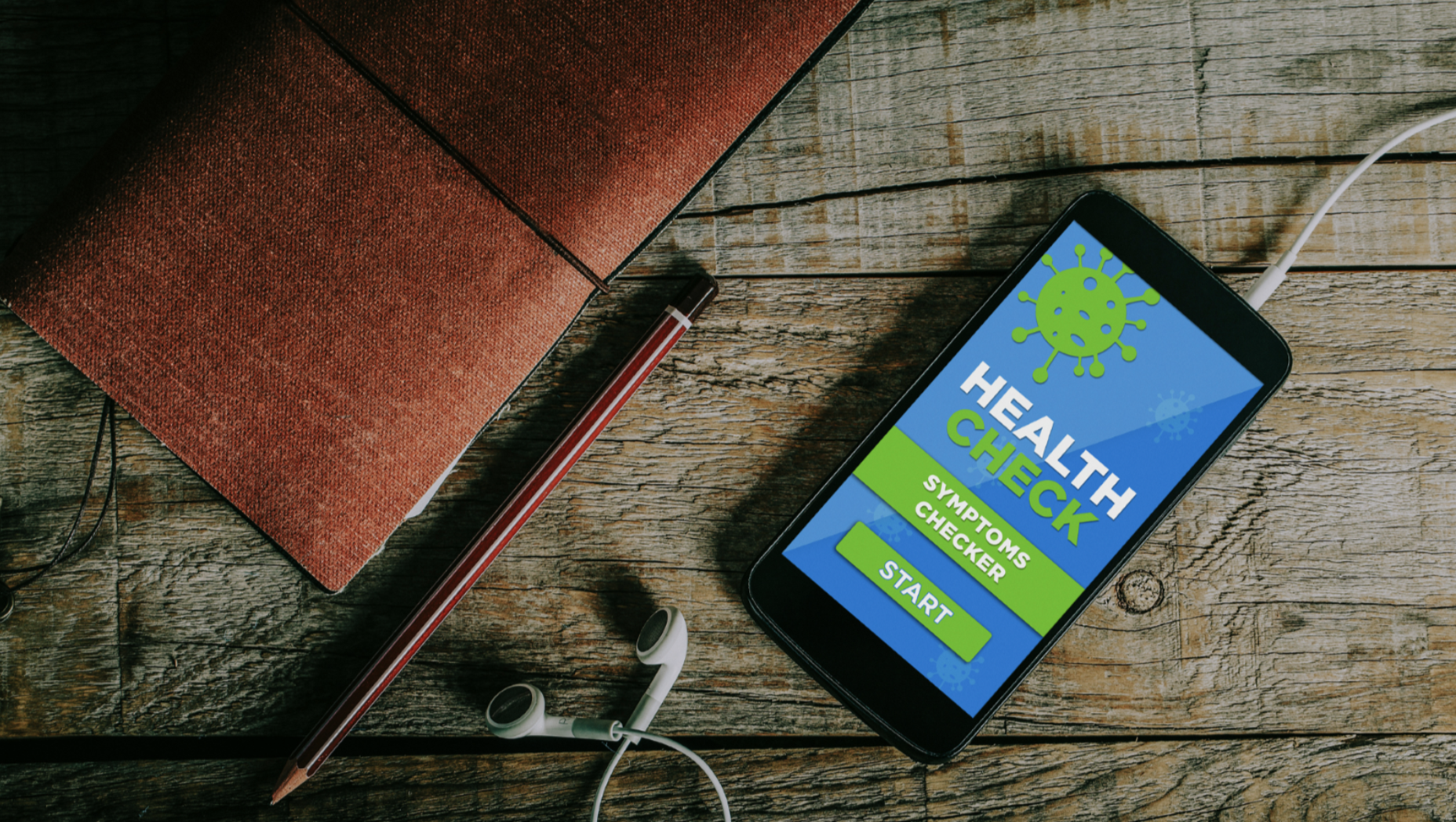
What about the use of apps? There are more than 300,000 health-related apps on the market today, with a 37% increase in usage since the pandemic began, especially in the area of mental health. With apps for everything from tracking our weight and heartbeat to counting the number of steps we take and the hours of sleep we get, it’s hard not to interact with one of these apps to streamline our lives and make them a little simpler. When it comes to the collection of data, however, how do we know what’s protected under HIPAA? Covered entities under HIPAA include healthcare clearinghouses, most healthcare providers, and health plans. However, if an organization is creating an app on behalf of a covered entity (or one of the covered entity’s contractors), they are considered a business associate, meaning they must comply with HIPAA rules and regulations. This helpful website provides different scenarios on whether or not an organization would be covered. This means that we, as patients, must be cautious in what types of data are being collected and how it might be used, which can usually be found in an app’s privacy agreement or policy.
This also extends to use of wearable devices, including FitBits, Apple Watches, glucose monitors, and biosensors that collect patient-generated health data. According to a Gallup poll conducted at the end of 2019, 19% of U.S. adults wore a wearable fitness tracker, and a 2019 Washington Post article reported more than 3 million consumers wore a medical alert device. But how is this data regulated? When we collect data for our own purposes, the data does not fall under HIPAA regulations. However, should a healthcare provider ask a patient to submit data from that device and integrate it into their organization’s EHR system, a covered entity, it becomes protected by HIPAA.
In conclusion, is telemedicine safe? The quick answer is yes and no. In an article released by the Patient Safety Network of the Agency for Healthcare Research and Quality, two physicians noted that “Studies have shown that telemedicine promotes continuity of care, decreases the cost of care, and improves patient self-management and overall clinical outcomes.” However, new technologies present new challenges that have to be worked through. This means that more research needs to be conducted and improvement processes be put in place to ensure protection of patient data. In the meantime, here are some safeguards healthcare organizations may put into place to establish peace of mind for patients:
- Be aware of updates from the OCR related to HIPAA
- Train providers and staff on policies, practices, and protocols for using telehealth services
- Make sure that your telemedicine portal confirms the security of patient data through the use of incident reporting, monitoring of security events, and strong levels of encryptions
- Have a strong authentication method, preferably two-factor
- Create a detailed audit log of user logins and meeting connections
Carly Flumer is a young woman who was diagnosed with stage I papillary thyroid cancer at the age of 27. She recently received her Master’s degree from Boston University in Health Communication and received her Bachelor’s from George Mason University in Health Administration and Policy. While being diagnosed with the “C” word at such a young age was a surprise, as it would be to anyone, she found strength, support, and inspiration in sharing her cancer journey on social media. As a result of her health outcome, she looks to advocate for other cancer patients through education, research, and health literacy.
Will Telemedicine Be a Mainstay for Myeloma Patients After the Pandemic?
The Patient Empowerment Network (PEN) is fostering change toward achieving equitable healthcare for all. One resource, the Myeloma TelemEDucation Empowerment Resource Center is to significantly improve multiple myeloma patients’ and caregivers’ familiarity with remote access to healthcare, and thus increase quality of care regardless of geographical location. This one-of-a-kind resource center is intended to educate the myeloma community on the practical usage of telemedicine tools, to humanize patient and provider experiences.
Here’s a summary view of the knowledge gained about telemedicine to help provide optimal care to myeloma patients and to aid in receiving optimal care no matter virus limitations, where patients live, and other factors.
Benefits and Limitations of Telemedicine Visits
There are both benefits and limitations of telemedicine visits. Some benefits of telehealth include:
- Telemedicine allows care providers the opportunity to determine when myeloma patients really need to be seen in-person.
- Standard of care and maintenance treatment are usually a good fit for using some telemedicine visits in clinical trials.
- The option to get laboratory work done closer to home is a benefit for saving travel time and from taking time off of work and also lessens patient exposure to viruses.
- Telehealth allows care providers the opportunity to meet family members of some patients who can’t make it to in-person visits and to get to know their patients on a more personal level.
- Care providers are now able to provide second opinions to patients in other parts of their state and even to some patients across the country.
Unfortunately, some limitations of telehealth include:
- Gauging toxicity and other things with new treatments are usually best done along with performing a physical exam.
- Some patients only have technology access to talk over the phone and don’t have access to use video due to their device or due to lack of Wi-Fi bandwidth.
- Physical examinations cannot be performed via telehealth visits.
- Some providers feel it’s more difficult to establish a bond with some patients and to have considerable discussions with then over telemedicine.
- Open and honest communication between patients and care providers is sometimes better served in-person.
How to Optimize a Telemedicine Visit
Just like in-person care visits, telemedicine visits are scheduled with a time limit in mind. Some things to remember about telemedicine visits are:
- Try to write down your questions for your doctor or care provider before your appointment to keep on track. Keep it next to you for easy access during your visit.
- If patients normally have a friend or loved one join or doctors have a nurse or pharmacist join for in-person visits, have them join your telemedicine visits to help take notes, to ask questions, and/or to provide answers or additional information.
- If a video conferencing tool is needed for your visit, install the tool on your laptop, tablet, or smartphone ahead of time to prevent rushing before your appointment. If possible, try to test the video conferencing tool with a friend or loved one a day or so ahead of your appointment.
- If there’s anything you don’t understand during the appointment, ask your doctor to explain it again – whether it’s medication instructions, test results, a new medical term, or anything else.
- If you feel like a treatment isn’t working well for you, ask your doctor about possible medication or dosage changes.
- Just like in-person doctor visits, your doctor or care provider may run a few minutes late. Try your best to remain flexible and to be patient.
Telemedicine and Multiple Myeloma Clinical Trials
To the surprise of some, telemedicine has taken a role in multiple myeloma clinical trials. Currently, and looking to the future, patients can expect:
- Telemedicine to continue as an option for follow-up visits along with in-person visits in clinical trials.
- Paperwork for clinical trials to be available to complete online for an easier process for joining clinical trials.
- Multiple myeloma clinical trials to provide optimal care through the use of both telemedicine and in-person visits.
- Telemedicine to provide more options for clinical trial access for those who live in remote areas.
- Multiple myeloma clinical trials for quality-of-life studies, engagement studies, educational studies, and possibly others to be available via telemedicine.
Financial Benefits of Telemedicine
Telemedicine has brought some financial benefits for multiple myeloma patients, including:
- Telemedicine saves the time and costs of traveling to appointments and can reduce or sometimes eliminate the need to take time off from work for an appointment.
- The option of connecting with your doctor via telemedicine can sometimes eliminate the need for costly urgent care visits.
- The use of telemedicine eliminates the need to find child care for patients and care partners with young children who couldn’t take them along to in-person doctor appointments.
Telemedicine Glossary
Here are some helpful telemedicine terms to know:
- HIPAA – HIPAA, or the Health Information Portability and Accountability Act, is a healthcare compliance law providing data security and privacy for the safeguarding of patient medical information. In telemedicine, provider-patient communication must take place through HIPAA-compliant secure platforms.
- Patient portal – a secure Internet sign-on that allows patients to contact their provider, review medical tests and records, access health education materials, and seek appointments. Most provider networks develop a patient portal before they move to full video appointments.
- Remote monitoring – type of ambulatory healthcare where patients use mobile medical devices to perform a routine test and send the test data to a healthcare professional in real-time.
- VPN – a VPN, or virtual private network, is a secure and private way to connect to the Internet over public wireless connections. VPNs are particularly important for those living the digital nomad lifestyle and connecting in foreign countries where networks may be more vulnerable to communication transmission interference.
Now that telemedicine tools continue to increase in use and to be refined, multiple myeloma patients can feel hopeful about improved care and treatment ahead for patients. As a step in that direction, take advantage of the resources below and continue to visit the Myeloma TelemEDucation Empowerment Resource Center for informative content about multiple myeloma and telemedicine.
Resources for Telemedicine and Multiple Myeloma
Are There Limitations of Telemedicine for Multiple Myeloma Patients?
How Will the Pandemic Impact Multiple Myeloma Trials?
Is Telemedicine Here to Stay for Multiple Myeloma Care?
What Are the Benefits of Telemedicine for Myeloma Patients?
How to Make the Most of a Virtual Visit
Telemedicine & Second Opinion Options
What Are Best Practices for Multiple Myeloma Patients Utilizing Telemedicine?
How Can Myeloma Patients Reduce Infection Risks During Medical Appointments?
Financial Resources for Patients and Families
Will Telemedicine Mitigate Financial Toxicity for Myeloma Patients?
Will Telemedicine Be a Long-Term Survival Tool for Myeloma Patients?
How Will Telemedicine Impact Multiple Myeloma Clinical Trials?
How Will Telemedicine Impact Multiple Myeloma Clinical Trials? from Patient Empowerment Network on Vimeo.
What impact has telemedicine had on multiple myeloma clinical trials, and what effect will it have on trials in the future? Expert Dr. Joseph Mikhael explains the impact of telemedicine early on in the COVID-19 pandemic, how he uses virtual visits with his patients currently, and the role and benefits of telehealth in the future of myeloma care.
See More From the Myeloma TelemEDucation Empowerment Resource Center
Related Resources:
Transcript:
Dr. Joseph Mikhael:
COVID-19 has impacted our lives in just about every way imaginable, and in multiple myeloma, sadly has very much impacted our ability to conduct clinical trials. Thankfully, now that we are out of the immediate acute phase when many trials were suspended, we actually have been able to work around this in general, where now we’ve been able to re-introduce studies and bring in new studies, of course, and we can do so in a more careful manner. Many of our clinical trials now are allowing intermittently to have telemedicine visits, which reduces the traffic for patients and makes it a little bit smoother. Some of the questionnaires and the things that we used to have to fill out on paper or physically in-person now can be done electronically, and so I think in many respects, we’ve really overcome most of the barriers so that we can continue the outstanding work and clinical trials to provide options for our patients that were not available before.
And looking to the future, I hope, even paradoxically in some way that this may — now that we’ve developed a more sophisticated telemedicine platform — it may allow us to do more and perhaps reach patients that may not have been reached before, there are already studies and trials that are being done through telemedicine, not necessarily a drug trial but quality of life studies, engagement studies, educational studies, different ways that we can enhance a patient’s experience and investigate better ways of doing things now that we can do so more fully electronically.
So, when I think of telemedicine and the future in multiple myeloma, I think it will continue to have a role in the long term. I think, much like people think that there will be more virtual meetings, I think we all want to get back to in-person meetings of various types and sizes and shapes, there will always be a component of virtual, and I can think even in my own practice and some patients that have quite a long drive to come down to see me, that they will still have to have face-to-face visits, but intermittently when the things are going well, follow-up like visits where the discussion may be limited.
I think there will be a role for this so that we can leverage the best of telemedicine and the best of in-person medicine so that the patients can receive the best care possible.

